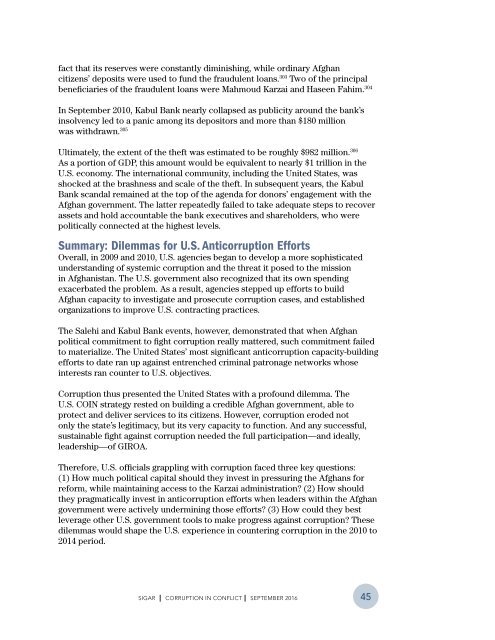CORRUPTION IN CONFLICT
5IlaWjQej
5IlaWjQej
You also want an ePaper? Increase the reach of your titles
YUMPU automatically turns print PDFs into web optimized ePapers that Google loves.
fact that its reserves were constantly diminishing, while ordinary Afghan<br />
citizens’ deposits were used to fund the fraudulent loans. 303 Two of the principal<br />
beneficiaries of the fraudulent loans were Mahmoud Karzai and Haseen Fahim. 304<br />
In September 2010, Kabul Bank nearly collapsed as publicity around the bank’s<br />
insolvency led to a panic among its depositors and more than $180 million<br />
was withdrawn. 305<br />
Ultimately, the extent of the theft was estimated to be roughly $982 million. 306<br />
As a portion of GDP, this amount would be equivalent to nearly $1 trillion in the<br />
U.S. economy. The international community, including the United States, was<br />
shocked at the brashness and scale of the theft. In subsequent years, the Kabul<br />
Bank scandal remained at the top of the agenda for donors’ engagement with the<br />
Afghan government. The latter repeatedly failed to take adequate steps to recover<br />
assets and hold accountable the bank executives and shareholders, who were<br />
politically connected at the highest levels.<br />
Summary: Dilemmas for U.S. Anticorruption Efforts<br />
Overall, in 2009 and 2010, U.S. agencies began to develop a more sophisticated<br />
understanding of systemic corruption and the threat it posed to the mission<br />
in Afghanistan. The U.S. government also recognized that its own spending<br />
exacerbated the problem. As a result, agencies stepped up efforts to build<br />
Afghan capacity to investigate and prosecute corruption cases, and established<br />
organizations to improve U.S. contracting practices.<br />
The Salehi and Kabul Bank events, however, demonstrated that when Afghan<br />
political commitment to fight corruption really mattered, such commitment failed<br />
to materialize. The United States’ most significant anticorruption capacity-building<br />
efforts to date ran up against entrenched criminal patronage networks whose<br />
interests ran counter to U.S. objectives.<br />
Corruption thus presented the United States with a profound dilemma. The<br />
U.S. CO<strong>IN</strong> strategy rested on building a credible Afghan government, able to<br />
protect and deliver services to its citizens. However, corruption eroded not<br />
only the state’s legitimacy, but its very capacity to function. And any successful,<br />
sustainable fight against corruption needed the full participation—and ideally,<br />
leadership—of GIROA.<br />
Therefore, U.S. officials grappling with corruption faced three key questions:<br />
(1) How much political capital should they invest in pressuring the Afghans for<br />
reform, while maintaining access to the Karzai administration? (2) How should<br />
they pragmatically invest in anticorruption efforts when leaders within the Afghan<br />
government were actively undermining those efforts? (3) How could they best<br />
leverage other U.S. government tools to make progress against corruption? These<br />
dilemmas would shape the U.S. experience in countering corruption in the 2010 to<br />
2014 period.<br />
SIGAR I <strong>CORRUPTION</strong> <strong>IN</strong> <strong>CONFLICT</strong> I SEPTEMBER 2016<br />
45


